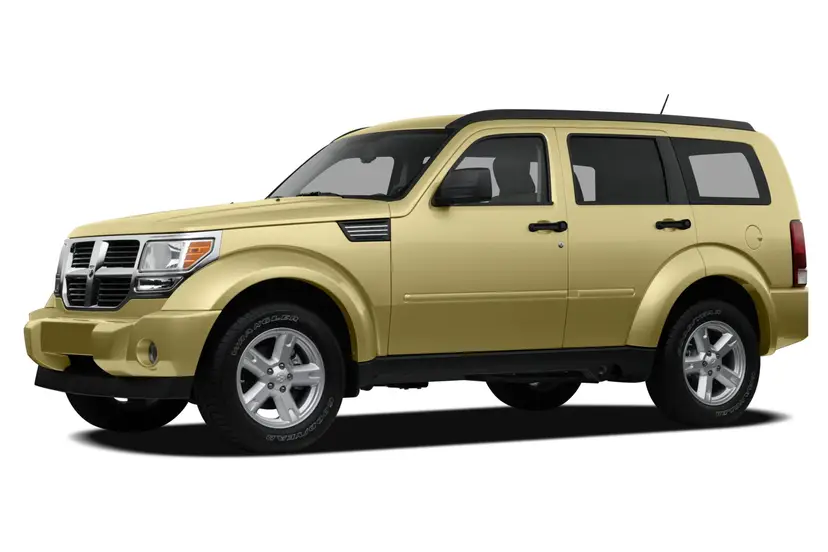
The Dodge Nitro is an endangered species. You might be thinking that’s because it’s a Dodge or because it’s a Nitro, but it’s on the endangered list mainly because it’s a truck-based SUV. Even before the gas-price spikes and economic meltdown of 2008, buyers had been migrating toward car-based SUVs, or crossovers, another species under the SUV genus that mutated out of traditional SUV lines and often bears a similar look. (Work with me; I’m trying to justify two years as a biology major.) This species has evolved to prosper in a changing environment because its members offer better mileage and are typically more space-efficient — without giving up what Americans have come to appreciate about SUVs: the higher ride height, all-wheel drive and a cargo hatch rather than a trunk.
Crossovers include some top sellers, such as the Honda CR-V and Toyota RAV4, but because I’m sick to death of seeing Japanese products held up as superior to every car, every truck, every thought out of Detroit, I’ll keep this all in the country and instead compare the Nitro to the Ford Escape, itself a popular compact-SUV-looking crossover. Even among endangered species, some individuals survive and some don’t, and I suspect the Nitro isn’t going to make it much longer.
| Compact SUVs Compared | |||||||||||||||||||||||||||||
|---|---|---|---|---|---|---|---|---|---|---|---|---|---|---|---|---|---|---|---|---|---|---|---|---|---|---|---|---|---|
| Dodge Nitro | Ford Escape | ||||||||||||||||||||||||||||
| Starting MSRP | $22,240 | $20,435 | |||||||||||||||||||||||||||
| Max. EPA mpg (city/highway) | 16/22 | 22/28 | |||||||||||||||||||||||||||
| Length (in.) | 178.9 | 174.7 | |||||||||||||||||||||||||||
| Width (in.) | 73.1 | 71.1 | |||||||||||||||||||||||||||
| Height (in.) | 69.9 | 67.8 | |||||||||||||||||||||||||||
| Cargo volume (backseat up/folded, cu. ft.) |
32.1/65.2* | 29.2/66.3 | |||||||||||||||||||||||||||
| Cargo floor height (in.) | 33.3 | 29.4 | |||||||||||||||||||||||||||
| Std. towing (lbs.) | 3,500 | 1,500 | |||||||||||||||||||||||||||
| Max. towing (lbs.) | 5,000 | 3,500 | |||||||||||||||||||||||||||
| Passenger volume (cu. ft.) | 102.5 | 99 | |||||||||||||||||||||||||||
| *75.6 cu. ft. including standard folding front passenger seat. Source: Manufacturers |
|||||||||||||||||||||||||||||
The disparity is pretty evident. The Nitro is a few inches longer, wider and taller, yet it has less cargo space than the Escape when the backseats are folded. Passenger volume is just 3.5 cubic feet ahead of the Escape’s. These are all reasonably close, but their gas mileage is decidedly not. Shown are the highest possible EPA estimates for both models, based on two-wheel drive and the smaller of each model’s two available engines. (The Escape’s 22 mpg city is with a manual transmission, but its city mileage only drops 2 mpg with the optional automatic.) The towing figures show each model’s worst- and best-case scenarios. In addition to its superior tow ratings, the Nitro needs only some trailering options to increase its capacity from 3,500 to 5,000 pounds, regardless of engine choice. To reach maximum towing capacity, the Escape requires both the higher-priced V-6 and an optional trailering package.
If you want to do real off-roading, it’s no contest, because the Nitro began its life as a Jeep Liberty. It has the strength and hardware to do things the Escape can’t. However, the incidence of true off-road driving — the kind a Nitro could do but an Escape couldn’t — is a small percentage. Beyond its towing superiority, the Nitro’s advantages aren’t really quantifiable.
Dead Weight on Pavement
If you don’t want to do serious off-roading, the Nitro’s heavy-duty construction and four-wheel drive represent a lot of dead weight the Escape doesn’t have. That’s a downside, but it doesn’t end there: My test Nitro’s part-time four-wheel drive was clearly an inferior means of keeping moving on snow and ice compared with the lighter all-wheel drive on the Escape and most other crossovers. Part-time four-wheel drive must be turned on and off by means of a knob on the center console, so already you’re doing something you needn’t do in the Escape, where the all-wheel drive does everything automatically.
Then you have to make sure you turn it back to rear-wheel drive when on dry (or just non-slippery) pavement. Part-time four-wheel drive has no center differential, so the front and rear wheels can’t turn at different speeds — which is what they need to do when you turn. Turning starts a tug-of-war between the front and back that binds the driveline and can make the truck even less controllable. In some circumstances you can turn it on once and turn it off much later, but when going from ice to dry to ice to dry to a snow patch in an urban or suburban setting, it’s more than you want to be dealing with. Granted, there are instances where the part-time system’s 50/50 split would be better than the Escape’s, but that’s likely the exception, not the rule.
Thankfully, the standard traction control and electronic stability system made the four-wheel drive less necessary than it otherwise would have been: It kept the rear end under control when I encountered the odd slick intersection.
Not a Bad Truck to Drive
Driving the Nitro overall was perfectly agreeable. It rides differently than a crossover, but I wouldn’t say it’s worse. The handling is a bit ponderous, but I’m convinced buyers often buy trucks because of — not in spite of — their trucklike characteristics. I had no problem with the base 3.7-liter engine’s acceleration, which is good news because the optional 4.0-liter adds $990 to the already higher-priced SLT and R/T trim levels, and it takes away 1 mpg in highway driving and — on four-wheel-drive models — 1 mpg in the city. On paper, the four-speed automatic transmission looks like a liability, and it probably doesn’t help the mileage, but I liked the way my Nitro responded when I hit the gas pedal. Unfortunately, not everything you see on paper can be ignored….
Safety
Another strike against the Nitro is its crash-test performance: It scores Good in the Insurance Institute for Highway Safety’s frontal crash test, but it scores Marginal in the side impact and Poor in the rear impact. The side test is the great equalizer: It’s the one that can be compared across different vehicle sizes and classes because the sled that rams all test subjects is the same size and weight. There are cars of all sizes and heights — including subcompacts and peewees like the Smart ForTwo — that score Good and Acceptable. A Marginal rating is hard to swallow in a truck with standard side-impact airbags. (See the full list of safety features here.)
Nitro in the Market
The bad news continues when you consider the Nitro’s poor reliability history. The Jeep Liberty shares the Nitro’s crash ratings and has better — but still below-average — reliability. Both models could be revived, but only the Liberty should be. Now is a time for cutting back, and it’s neither necessary nor wise for all brands to try satisfying all buyers. There will always be demand for real offroad SUVs, but not like we’ve seen before, and the brand that should meet that demand is Jeep. With its shorter wheelbase and other provisions, the Liberty is the superior off-roader, and its Jeep heritage brings authenticity for the folks most devoted to SUVs.
If you’re more interested in the crossover species, Jeep also has a compact that’s a good deal more offroad-capable than the Escape and most others: the Patriot. It’s affordable and the most fuel-efficient in its class, at 23/28 mpg. It has shown above-average reliability, and it scores Good in IIHS frontal and side-impact crash tests — when equipped with optional side torso airbags (Marginal without). Both the Patriot and the Liberty are built in the U.S., as you’d want a Jeep to be. Though the Nitro’s disappearance could cost Dodge and its dealers some sales initially, in the long run it would make for a healthier market — something we homo sapiens desperately need.
| Send Joe an email |



































